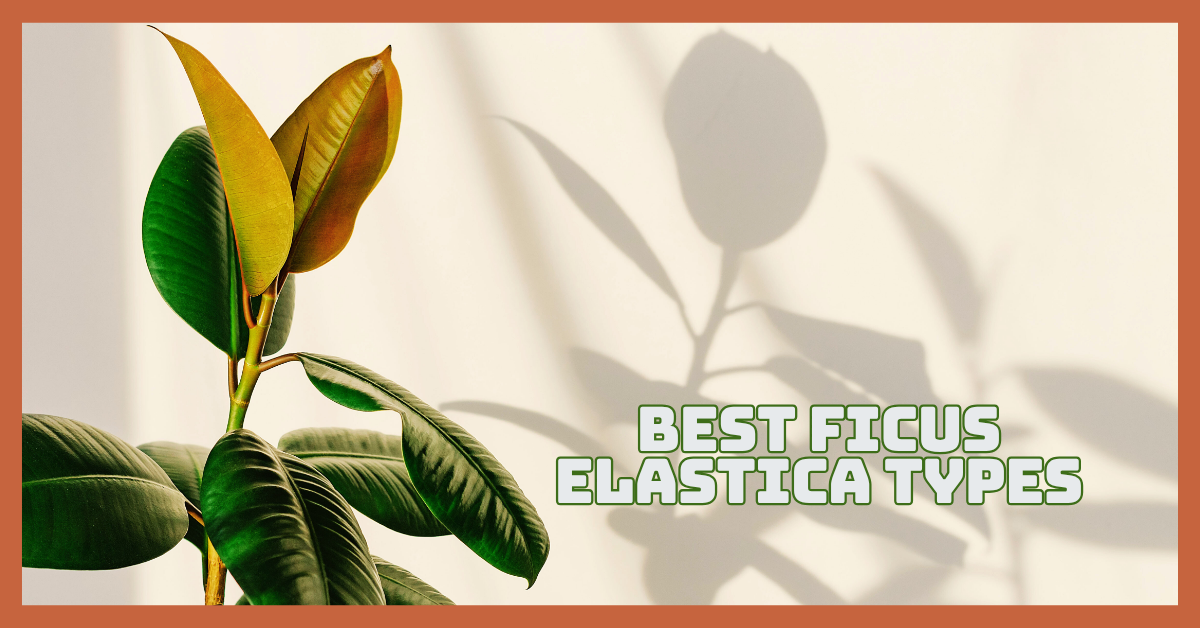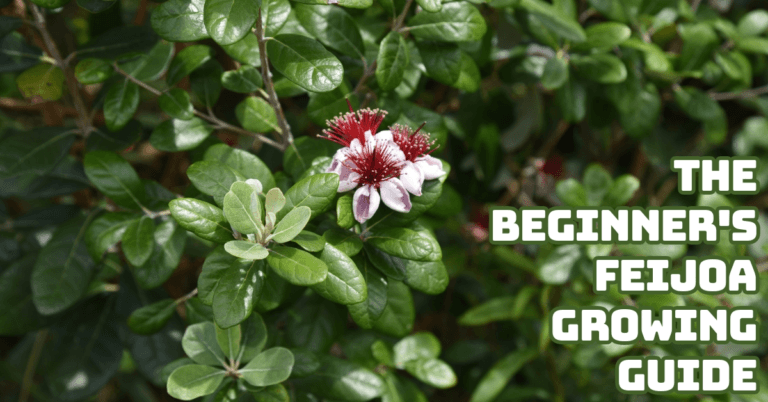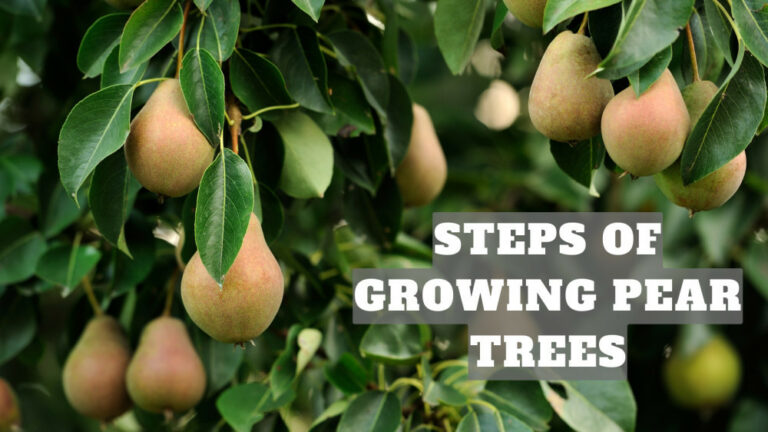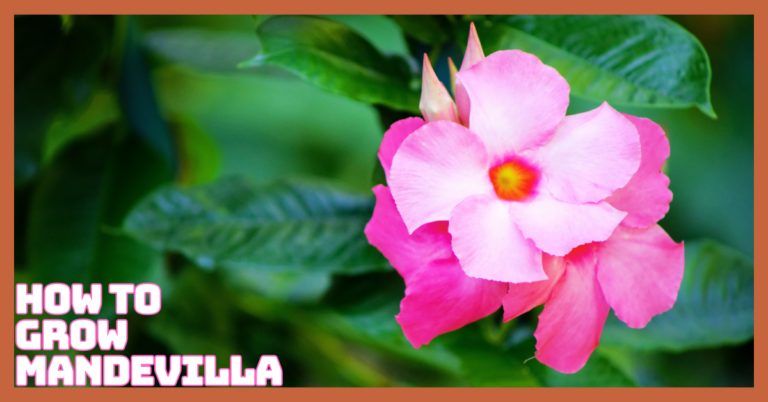Best Ficus Elastica Types For A Lush & Happy Home
Ficus Elastica types are loved for their bold foliage, vibrant colours, and easy-care nature, making them perfect for any indoor space. These versatile houseplants add a touch of natural beauty to homes, offices, and cozy corners.
Whether you’re a beginner or a plant enthusiast, exploring different varieties opens up exciting décor possibilities. In this guide, discover the most stunning Ficus Elastica types you’ll love growing indoors.
Types Of Ficus Elastica
These easy-to-care-for houseplants come in stunning shapes and colours, from deep green classics to striking variegated types. Let’s explore your top choices!
1. Ficus elastica Robusta
Ficus elastica Robusta is a classic rubber plant loved for its large, glossy leaves and hardy nature. It’s perfect for adding bold greenery and purifying the air in any indoor space.
Features
Robusta has broad, deep green leaves with a prominent midrib and thick, leathery texture. This variety grows upright and sturdy, making it an eye-catching statement plant. Its robust foliage can reach impressive sizes, giving your room a lush, tropical feel.
Uses
Perfect for homes and offices, Robusta helps remove indoor toxins like formaldehyde. Use it as a striking corner plant, an elegant focal point, or to create a calming, green backdrop that enhances well-being and brings nature inside.
Growing Tips
Ficus elastica Robusta thrives in bright, indirect light but can handle lower light areas too. To prevent soggy roots, make sure the pot drains properly and water when the top inch of soil feels dry.
A peat-based or well-draining mix works best. Clean the leaves regularly to keep them shiny and healthy. Use a balanced fertilizer once a month during the spring and summer.
Average indoor humidity is fine, but it appreciates a bit more moisture in the air. Every few weeks, rotate the plant to ensure even growth. Prune to control height and shape.
Although it is usually cultivated indoors in colder climates, it is suitable for outdoor cultivation in USDA Zones 10–12. To achieve the most outstanding results, keep it away from drafts and abrupt temperature changes.
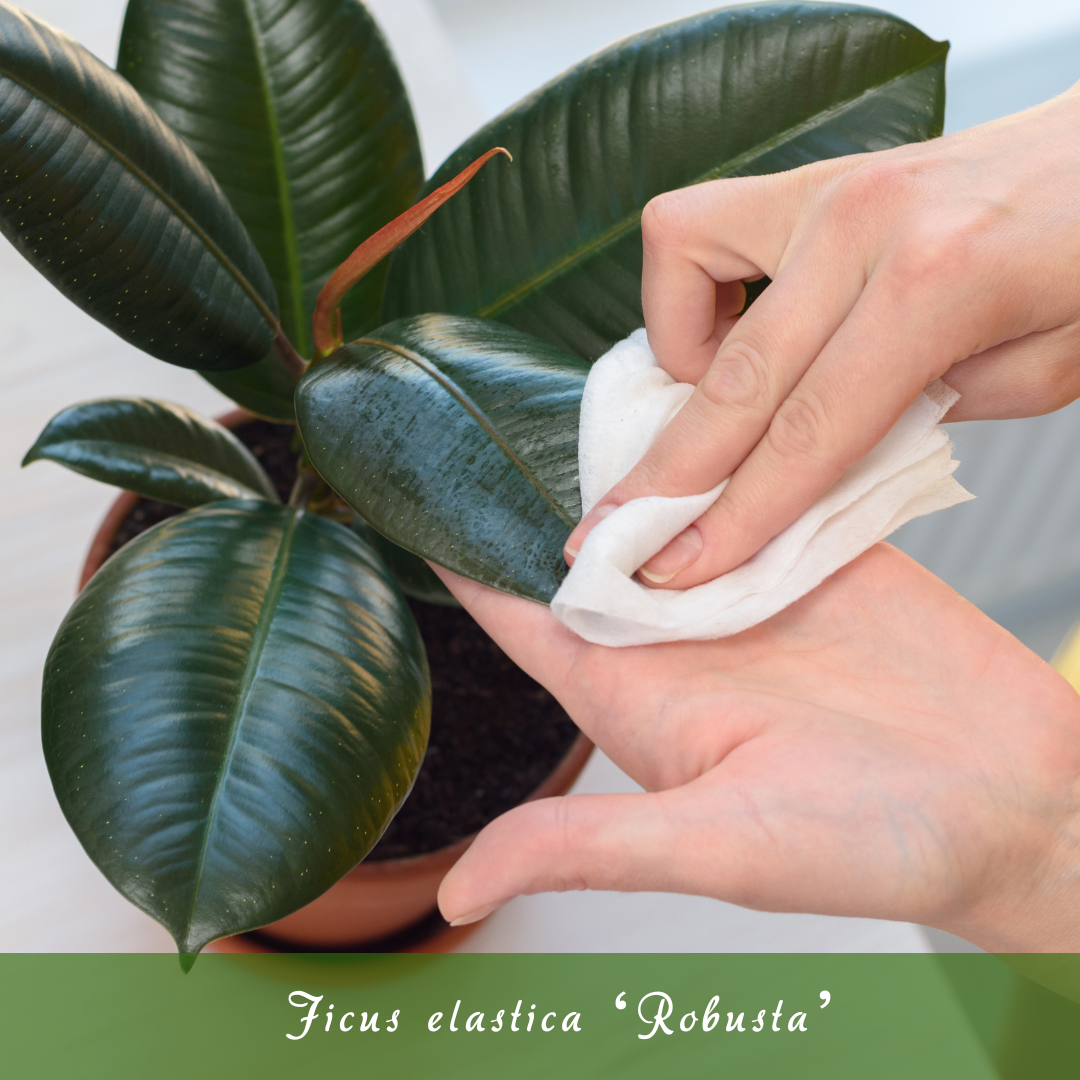
2. Ficus elastica Decora
Among the many types of rubber plants, Ficus elastica Decora stands out for its broad, glossy leaves and sophisticated tropical appeal. It’s perfect for adding a refined, tropical vibe indoors.
Features
Decora features large, oval-shaped leaves with a thick, leathery texture and a subtle burgundy or bronze hue on new growth.
Its prominent central vein adds character. This variety grows upright and can reach impressive indoor heights, creating an attractive, lush focal point.
Uses
This stylish plant purifies indoor air by filtering toxins like formaldehyde and is ideal for homes, offices, or reception areas. Use Decora as a dramatic accent plant in bright corners, a backdrop for more miniature houseplants, or to elevate modern interior décor.
Growing Tips
Ficus elastica Decora can withstand minor shade but thrives in bright, indirect light. Avoid direct harsh sunlight, which may scorch its leaves.
To avoid root rot, make sure there is enough drainage and water when the top inch of soil feels dry. Wipe leaves frequently to keep them shiny and remove dust, and choose a potting mix that drains well and is rich in peat.
Apply a balanced liquid fertilizer once a month throughout the spring and summer growing season. Periodically turn the pot to ensure balanced growth.
Average indoor humidity is fine, but mist occasionally if the air is dry. To regulate size and promote bushier growth, prune.
Outdoors, it’s hardy in USDA Zones 10–12 but is mainly grown indoors in cooler climates. Keep away from drafts for best health.
3. Ficus elastica Ruby
One of the most colourful types of rubber plant is Ficus elastica Ruby, which is prized for its gorgeous variegated leaves that are pink, red, and green. It's ideal for bringing vibrant colour indoors.
Features
Ruby has broad, glossy leaves with a beautiful blend of creamy white, deep green, and striking pink or ruby-red tones. New growth often shows brighter pink edges. Its colourful foliage makes it a standout statement plant that brings playful elegance to any space.
Uses
Ideal for brightening living rooms, offices, or creative spaces, Ruby also helps purify indoor air. Use it as a striking accent plant, a centrepiece for plant shelves, or to add tropical flair and vibrant energy to modern interiors.
Growing Tips
Ficus elastica Ruby needs bright, indirect light to maintain its vivid variegation—insufficient light can dull its colours. Avoid direct afternoon sun, which may scorch the leaves.
To avoid root rot, make sure there is adequate drainage and water when the top inch of soil dries out. A well-draining, peat-based potting mix works well.
Regularly wipe leaves to maintain their colour and a dust-free condition. Use a balanced liquid fertilizer and fertilize once a month in the spring and summer.
Keep indoor humidity at an average level, but if the air is dry, spray occasionally. Rotate the plant for even growth and prune to manage its shape.
Best grown indoors in most climates; outdoors, it’s hardy in USDA Zones 10–12. Keep away from cold drafts and sudden temperature changes.
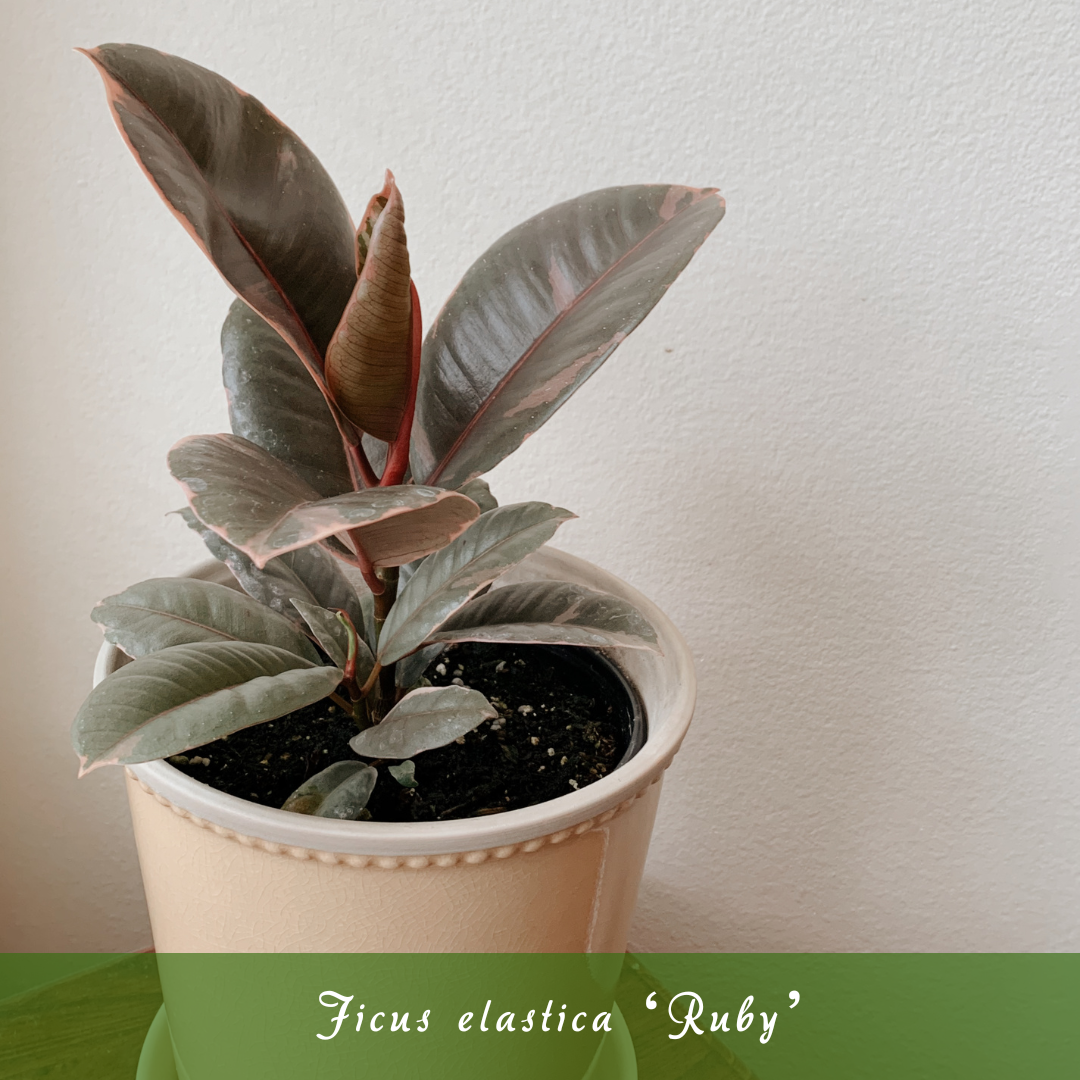
4. Ficus elastica Burgundy
Ficus elastica Burgundy is a popular rubber plant variety admired for its deep, dramatic foliage. It’s perfect for adding rich colour and a touch of tropical sophistication to indoor spaces.
Features
Burgundy features large, thick, glossy leaves with a dark green to almost black hue, accented by subtle burgundy undertones and a striking red midrib. Its bold foliage provides a dramatic look that works well in both modern and classic décor.
Uses
This plant naturally filters indoor air and makes a stunning statement piece. Use Burgundy as a focal point in living rooms, offices, or bright corners, or pair it with lighter green plants for beautiful contrast and depth.
Growing Tips
Ficus elastica Burgundy thrives in bright, indirect light but can tolerate moderate light; however, brighter conditions will enhance its deep colour.
Keep it out of direct hot sun, which can scorch the leaves. To prevent root rot, make sure there is enough drainage and water when the top inch of soil feels dry. Use a well-draining, peat-rich potting mix.
Clean leaves regularly to keep their shine and remove dust. On a monthly basis in the spring and summer, apply a balanced liquid fertilizer.
It grows well in average indoor humidity but benefits from occasional misting. Rotate periodically for even growth and prune to shape if needed.
Best grown indoors in cooler regions; hardy outdoors in USDA Zones 10–12. Defend against abrupt temperature swings and chilly drafts.
5. Ficus elastica Black Prince
Among the various types of rubber plants, Ficus elastica Black Prince is perfect for those who love bold, dramatic foliage indoors. It’s an excellent choice for adding bold, modern elegance to indoor plant collections.
Features
Black Prince showcases broad, glossy leaves that appear deep burgundy to nearly black, with a prominent midrib. New leaves may emerge with a subtle reddish hue before maturing to a darker shade. Its intense foliage colour creates a sophisticated, moody vibe perfect for contemporary interiors.
Uses
This variety purifies indoor air while doubling as a living design statement. Use Black Prince to create contrast among lighter plants, anchor a plant corner, or add dramatic visual interest to minimalist spaces, offices, or living rooms.
Growing Tips
Ficus elastica Black Prince thrives in bright, indirect light to maintain its deep, rich colouring, though it can adapt to medium light—just expect slower growth.
Keep it out of harsh direct sun to prevent leaf scorch. To avoid root rot, water when the top inch of soil is dry, making sure any extra water drains correctly.
Make use of an organic matter-rich potting mix that drains properly. Wipe the leaves occasionally to keep them dust-free and glossy.
Normal indoor humidity works well, but misting helps in dry climates. Rotate occasionally for even growth. Best grown indoors in most regions; hardy outdoors in USDA Zones 10–12. Keep it away from cold drafts for optimal health.
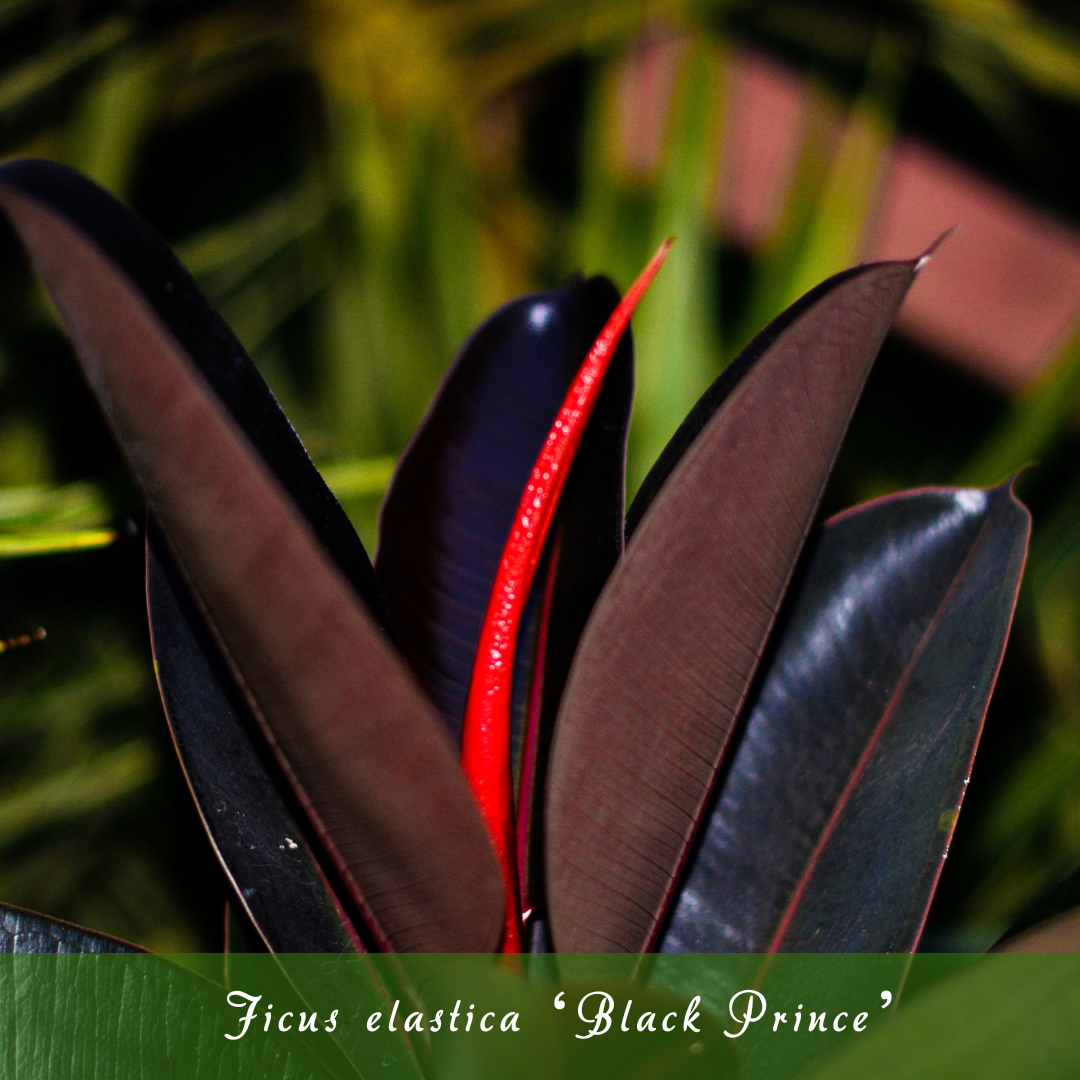
6. Ficus elastica Abidjan
Among the many types of rubber plants, Ficus elastica Abidjan is celebrated for its bold, dark foliage and rich burgundy tones. It’s perfect for adding a sophisticated tropical feel indoors.
Features
Abidjan showcases broad, leathery leaves that range from deep green to dark burgundy, sometimes appearing almost black.
New growth emerges with a subtle reddish tint, adding layers of colour. Its upright growth and glossy leaves make it a dramatic focal point in any room.
Uses
This variety naturally purifies indoor air and doubles as a stylish décor element. Use Abidjan to create contrast in plant groupings, highlight minimalist interiors, or add a moody, modern touch to living rooms, offices, or hallways.
Growing Tips
Ficus elastica Abidjan prefers bright, indirect light to maintain its rich colour, but can tolerate medium light, though growth may slow. Avoid direct, harsh sun that can scorch its leaves.
To avoid root rot, water the pot when the top inch of soil feels dry. Make sure the pot has adequate drainage. Make use of a potting mix that drains well and is high in organic matter.
Wipe the leaves regularly to remove dust and keep them glossy. Once a month in the spring and summer, apply liquid fertilizer. Average indoor humidity is fine, but occasional misting helps, especially in dry climates.
Rotate occasionally for even growth. Best grown indoors in most regions; hardy outdoors in USDA Zones 10–12. Protect from drafts and sudden temperature changes.
Turn Your Passion for Nature Into Income
🌿 Whether you love gardening, caring for animals, or exploring holistic living,
You can share your knowledge online and earn from it.
Discover how nature lovers are growing their passions into meaningful, income-generating blogs. 👇
7. Ficus elastica Variegata
Ficus elastica Variegata is a stunning rubber plant variety cherished for its unique marbled foliage. It’s perfect for adding fresh, eye-catching colour and tropical flair to bright indoor spaces.
Features
Variegata displays broad, glossy leaves with irregular patterns of green, cream, and sometimes pale yellow. New growth often has subtle pink or peach undertones.
Its striking variegation and bold structure make it an ideal statement plant for plant lovers who enjoy vibrant, patterned foliage.
Uses
This variety not only purifies the air but also serves as a decorative highlight. Use Variegata to brighten living rooms, home offices, or hallways. It pairs beautifully with other green plants, adding contrast, texture, and a lively, fresh vibe to your indoor jungle.
Growing Tips
Ficus elastica Variegata needs bright, indirect light to keep its beautiful colours vivid — too little light can cause the variegation to fade.
Avoid direct, intense sun, which can scorch its delicate leaves. Water when the top inch of soil feels dry, and ensure the pot drains well to prevent root rot.
Use a peat-rich, well-draining potting mix. To keep the leaves fresh and shiny, clean them on a regular basis. Use a liquid fertilizer once a month.
Rotate the plant for even growth and prune to maintain its shape. It adapts well to average indoor humidity but appreciates occasional misting.
Best grown indoors in most climates. Hardy outdoors in USDA Zones 10–12. Keep away from cold drafts.
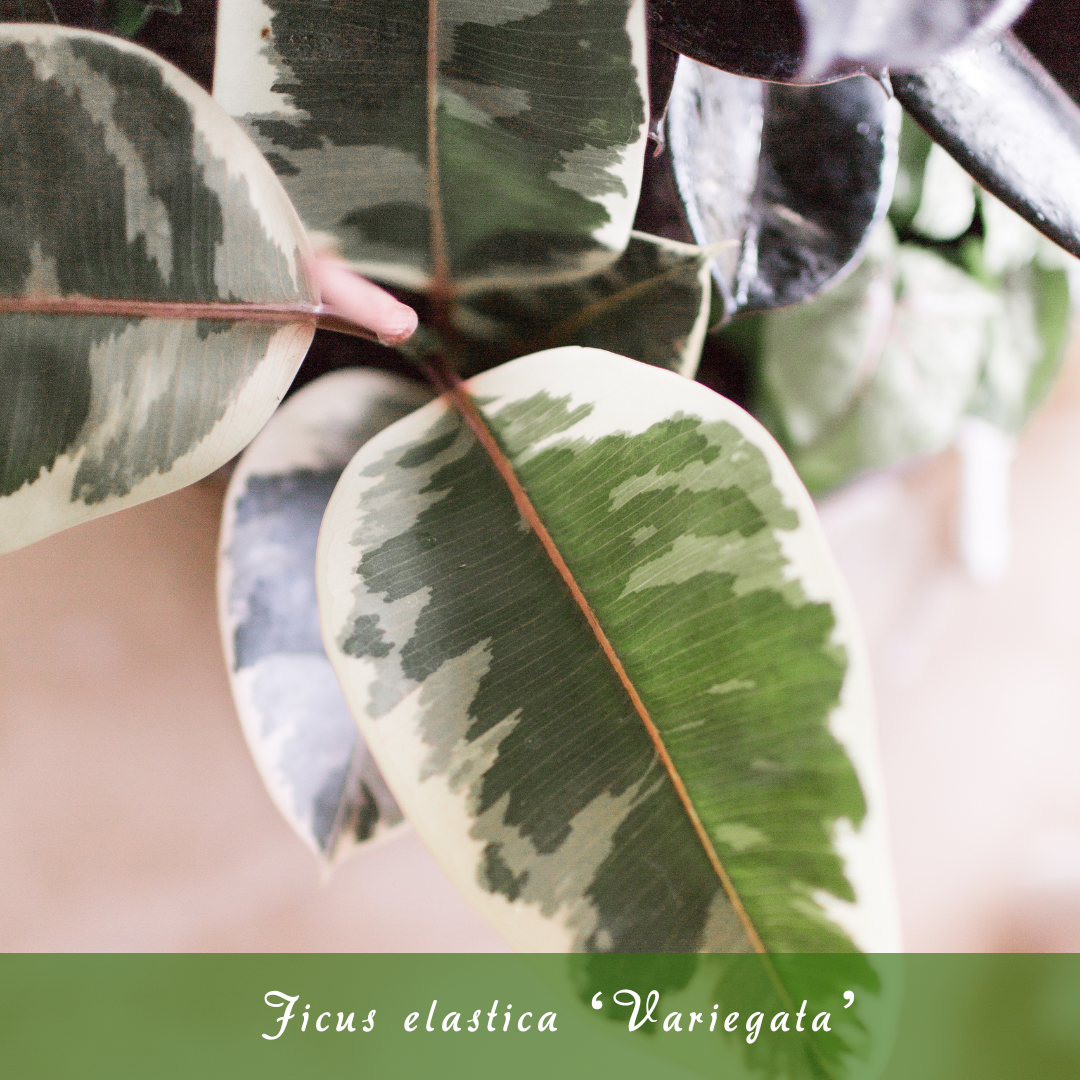
8. Ficus elastica Doescheri
Among the unique types of rubber plants, Ficus elastica Doescheri is prized for its striking marbled leaves and fresh decorative appeal. It adds a fresh, decorative touch to indoor spaces.
Features
Doescheri displays elongated, leathery leaves with irregular splashes of creamy white and pale green. New leaves often show subtle pink or bronze tints along the edges. Its distinctive variegation and elegant form make it an eye-catching choice for plant lovers seeking something different.
Uses
Perfect for homes, offices, or conservatories, Doescheri naturally purifies the air while serving as a striking ornamental plant. Use it as a bright focal point, to liven up empty corners, or to add texture and pattern to your indoor jungle.
Growing Tips
Ficus elastica Doescheri thrives in bright, indirect light to keep its variegation vivid—insufficient light can make the colours fade. Avoid direct harsh sun, which can burn its delicate leaves.
If the top inch of soil seems dry, moisten the pot and make sure it has enough drainage to prevent root rot. Make use of a potting mix that drains well and is high in organic matter.
Clean leaves regularly to maintain their beauty. In spring and summer, fertilize once a month with a balanced fertilizer. It prefers average indoor humidity but benefits from occasional misting.
Rotate for even growth and prune to control size. Outdoors, it’s hardy in USDA Zones 10–12 but is best grown indoors in cooler climates.
9. Ficus elastica Melany
Ficus elastica Melany is a compact, elegant rubber plant variety admired for its rich, dark green foliage and tidy growth habit. It’s perfect for small spaces needing a touch of lush greenery.
Features
Melany has slightly narrower, glossy leaves with a deep green hue and a subtle bronze undertone on new growth. Its upright, bushy form stays compact compared to other rubber plants, making it ideal for tabletops or shelves while still adding a bold, tropical vibe.
Uses
Perfect for apartments, desks, or small corners, Melany not only purifies indoor air but also brings a stylish, sophisticated touch to any room. Use it to add structure to plant groupings or as a classy accent in modern interiors.
Growing Tips
Ficus elastica Melany thrives in bright, indirect light but can handle some lower light conditions, though its growth may slow.
To prevent the leaves from being scorched, keep them out of the direct sun. Once the top inch of soil seems dry, moisten the pot so that it drains correctly.
Use a potting mix that drains well, such as peat-based soil. To keep leaves looking glossy and remove dust, wipe them frequently. Once a month during the spring and summer, fertilize with a balanced liquid fertilizer.
Occasionally, spraying helps, but average interior humidity is fine. To ensure uniform development, rotate the plant and trim it as necessary to keep its compact shape.
Outdoors, it’s hardy in USDA Zones 10–12 but is best grown indoors in most climates. Keep away from cold drafts and sudden temperature drops.
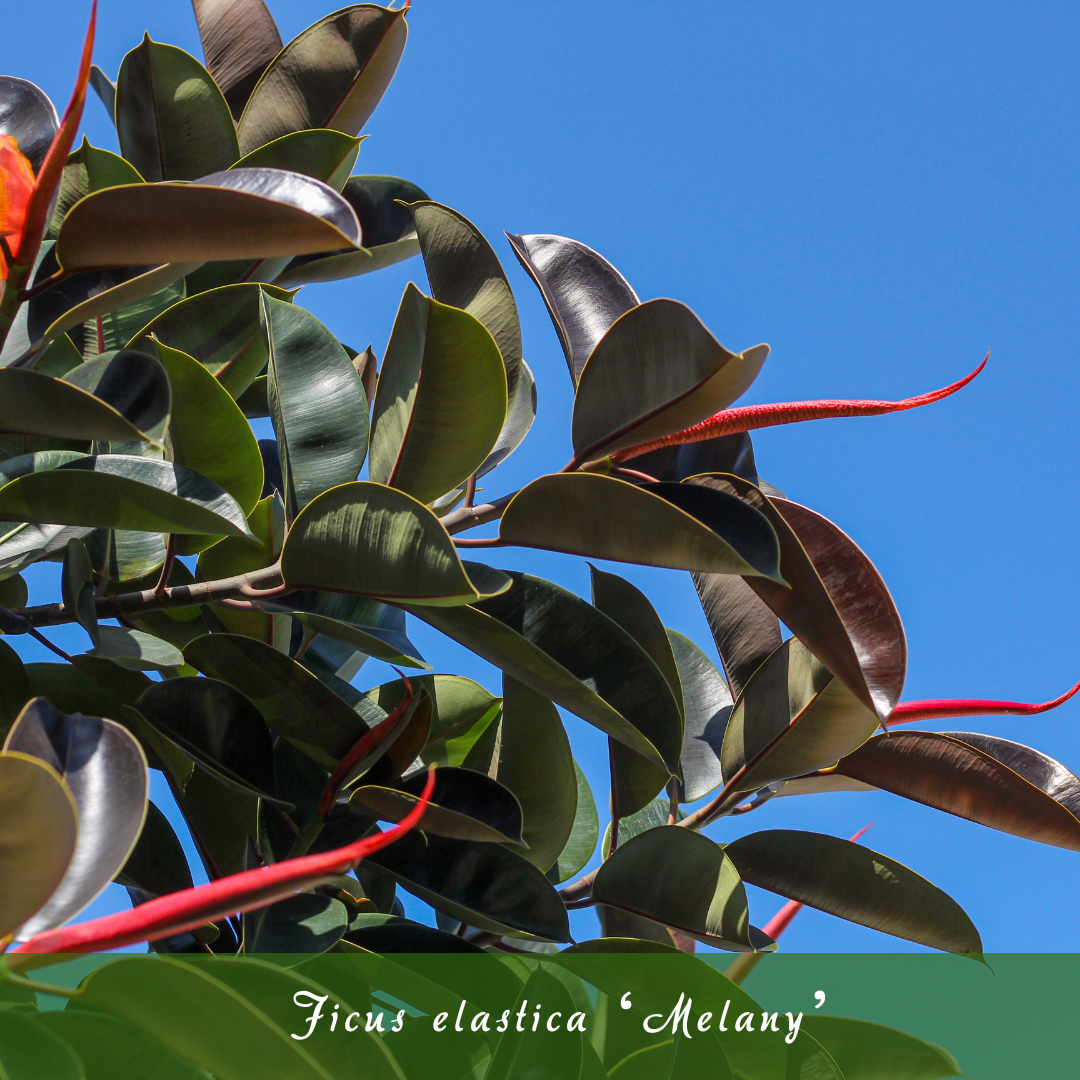
10. Ficus elastica Tineke
Among the different types of rubber plants, Ficus elastica Tineke is especially loved for its vibrant, variegated foliage. It’s perfect for brightening any indoor plant collection.
Features
Tineke showcases large, glossy leaves marbled with creamy white edges and splashes of soft green. New leaves often emerge with a subtle pink blush, adding extra charm. Its vibrant, variegated foliage makes it an eye-catching statement plant for modern, stylish interiors.
Uses
This plant not only purifies indoor air but also adds a pop of colour to living rooms, offices, or bright corners. Use Tineke to create a fresh, lively atmosphere and complement minimalist or contemporary décor with its unique variegated patterns.
Growing Tips
Ficus elastica Tineke thrives in bright, indirect light to maintain its beautiful variegation—too little light may cause the colours to fade.
Keep it away from harsh direct sun, which can scorch its delicate leaves. Use only well-draining potting mix and water when the top inch of soil seems dry. To avoid root rot, keep it out of the water.
Wipe the leaves periodically to keep them vibrant and dust-free. During spring and summer, fertilize once a month with a balanced liquid fertilizer. It prefers average indoor humidity but will appreciate occasional misting.
Rotate the plant for even growth. Hardy outdoors in USDA Zones 10–12, but best grown indoors in cooler regions. Keep away from cold drafts.
Conclusion
With so many beautiful Ficus Elastica types to choose from, adding charm and greenery to your space has never been easier.
Whether you love bold, classic, or variegated leaves, there’s a perfect variety waiting for you. Start your indoor gardening journey with confidence and enjoy the beauty these plants bring to your home. Happy growing!
I trust you enjoyed this article on the Best Ficus Elastica Types For A Lush & Happy Home. Please stay tuned for more inspiring guides, helpful tips, and ideas to help you live closer to nature every day.
Take care!
— JeannetteZ
💬 Your Opinion Is Important To Me
Do you have thoughts, ideas, or questions? I’d love to hear from you. Please leave your comments below or email me directly at Jeannette@Close-To-Nature.org.
📚 More Nature-Inspired Reads
Explore more ways to connect with nature, nurture your pets, and live in harmony with the world around you 🌿

